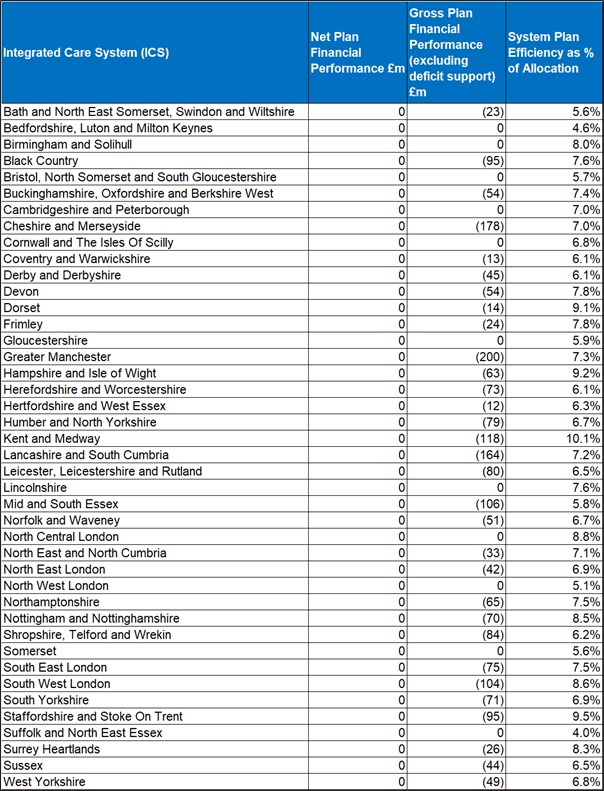Action required
The Board is asked to note the final 2025/26 planning position and discuss the next steps.
Background
1. We published the priorities and planning guidance for 2025/26 on 30 January 2025, and the formal nationally co-ordinated planning process is now complete with plans assured and agreed through the boards of NHS trusts and integrated care boards (ICBs).
2. At the end of February, systems reported a financial plan gap of £4.4 billion, even after accounting for £2.2 billion in revenue support. There was also limited confidence in the substance and deliverability of the plans submitted.
3. Since the March ‘reset’ moment, trusts and ICBs have worked intensively to strengthen plans for 2025/26. Where needed, regional teams have provided support, leading a risk-based intervention approach. In four of the most challenged systems, this also included a board-to-board meeting between the system and NHS England.
4. The final planning position and next steps are summarised below.
Finance and workforce
5. All systems are aiming to achieve a net balanced financial position in 2025/26. Without revenue support, this results in a £2.2 billion aggregate system deficit (see annex), meaning the initial £4.4 billion planning gap has been closed.
6. Boards have highlighted the level of challenge that will be involved in delivering this financial plan alongside operational performance ambitions. NHS England will continue to work closely with ICBs and trusts to monitor and support delivery.
7. Plan system efficiencies average 7.1% supported by reductions in temporary staffing, and corporate costs. The total workforce across substantive, bank and agency staff is planned to be 2.0% lower than in 2024/25, with agency use planned to reduce by 40% by March 2026.
Elective and cancer
8. In aggregate, NHS trust plans support delivery of the target to improve the percentage of patients waiting no longer than 18 weeks for treatment to 65% by March 2026. NHS England will continue to work with the small number of trusts not planning to meet their minimum improvement target.
9. The cancer 62 day and faster diagnosis standard targets of 75% and 80% are both planned to be met by March 2026.
Urgent and emergency care
10. All systems are planning to improve accident and emergency (A&E) waiting times, with all but one planning to meet the target of 78% of patients being admitted, discharged, and transferred from emergency departments within 4 hours in March 2026.
11. Plans also demonstrate an improvement in the proportion of patients admitted, discharged, and transferred from emergency departments within 12 hours across 2025/26 compared to 2024/25.
12. All ambulance trusts have plans to improve category 2 ambulance response times. The national average plan response time is 19 seconds above the 30 minute target. NHS England will continue to work closely with the three ambulance trusts not planning to meet the target.
Primary care and mental health
13. Plans support delivery of the national ambition to provide 700,000 more urgent dental appointments, reduce average length of stay in adult acute mental health beds, and increase the number of children and young people (CYP) accessing services to achieve the national ambition for 345,000 additional CYP aged 0–25 compared to 2019.
14. The target to reduce reliance on mental health inpatient care for people with a learning disability and autistic people by a minimum of 10% is also planned to be met.
Most challenged systems
15. At the start of the planning process, we identified twelve systems that would benefit most from targeted support. In their initial plan returns at the end of February, all twelve had planned for a deficit position, only one was planning to meet its target improvement against the 18-week standard, and five did not have a plan to meet the 4-hour A&E target. This has improved and each of the twelve systems have since submitted a balanced financial position, nine are planning to meet their 18-week target and all but one planning to meet the 4-hour A&E target.
16. Following their plan submissions at the end of March, four systems were escalated for a board-to-board meeting. Collectively, these systems had planned for a total net deficit of £212 million, and none expected to meet their 18-week target. After further focussed work, the financial position in each of the four system has improved to a balanced position, with half now planning to achieve their target improvement against the 18-week standard.
Next steps
17. The formal 2025/26 planning process has now concluded. Regional teams will continue to work with ICBs and trusts to address remaining concerns and risks through the appropriate delivery support routes, including where plans do not fully meet national performance expectations. Where specific support needs have been identified through the planning process this is being used to inform the deployment NHS England improvement resources. Delivery of financial plans will be supported by changes to the financial framework for 2025/26 and a review of local governance arrangements.
18. Publication of the 10 Year Health Plan and multi-year financial settlement for the public sector as part of the Spending Review 2025 will give us the ingredients to shift towards a medium-term approach to planning for 2026/27 and beyond. NHS England will work with systems to reform the nationally co-ordinated NHS planning processes and develop a shared set of expectations for medium-term planning. The work to build stronger foundations for effective strategic and operational planning will begin immediately informed by the lessons from this and previous planning processes.


